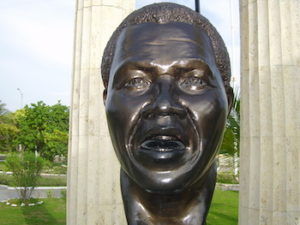
Benkos Biohó
(Bust, Statue)
*This date affirms Columbia’s independence from Spain and slavery. This article celebrates the birth of Benkos Biohó, one of the country’s greatest abolitionists.
Also known as Domingo Biohó was born in the late 16th century into an African royal family of the Bissagos Islands off the coast of Guinea-Bissau, West Africa. He was kidnapped by the Portuguese slave trader Pedro Gomes Reinel. Biohó was then sold to businessman Juan Palacios and transported to Colombia in South America. In 1596, he was sold again to the Spaniard Alonso del Campo in Cartagena de Indias. Biohó made his first escape when the boat transporting him down the Magdalena River sank. He was recaptured but escaped again in 1599 into the marshy lands southeast of Cartagena.
Biohó, the former African royalty, escaped again from the slave port of Cartagena with ten others and founded San Basilio de Palenque, then known as the "village of the maroons." He organized an army to dominate all of the Montes de María regions. He also formed an intelligence network and used the information collected to help organize more escapes and to guide the runaway slaves into the liberated territory, known as settlement. He used the title "King of Arcabuco."
On July 18, 1605, the Governor Casasola of Cartagena, unable to defeat the Maroons, offered a peace treaty to Biohó, recognizing the autonomy of the Matuna Bioho Palenque and accepting his entrance into the city armed and dressed in the Spanish fashion. Meanwhile, the Palenque promised to stop receiving more runaway slaves, cease their aid in escape attempts, and stop addressing Biohó as "king." Peace was established in 1612 under the governorship of Diego Fernández de Velasco.
The Spaniards violated the treaty in 1619 when they captured Biohó as he walked into the city. On March 16, 1621, the governor of Cartagena betrayed and hanged him. Governor García Girón, who ordered the execution, argued bitterly that "it was dangerous the extent to which Biohó was respected in the population" and that "his lies and enchantment would drive the nations of Guinea away from the city." The betrayal contributed to the history of distrust of Colombia’s government.
In 1713, San Basilio de Palenque became the first free village in the Americas by decree from the King of Spain when he gave up sending his troops on futile missions to attack their fortified mountain hideaway. By the end of the seventeenth century, the area of Montes de María had over 600 maroons under the command of Domingo Padilla, who claimed for himself the title of captain. At the same time, his wife Jane adopted that of the ruler and successfully challenged further attempts at sovereignty from the colonial authorities. UNESCO declared San Basilio de Palenque a Masterpiece of the Oral and Intangible Heritage of Humanity 2005. At about 50 miles east of Cartagena, hills of strategic value, used as lookout posts, still hear the names of the runaway neighborhood: Sincerin, Mahates, or Gambote.